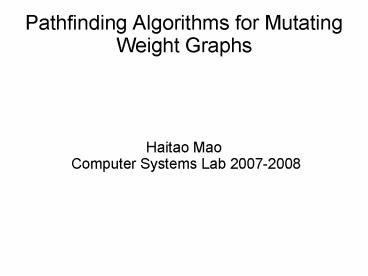Pathfinding Algorithms for Mutating Weight Graphs - PowerPoint PPT Presentation
Title:
Pathfinding Algorithms for Mutating Weight Graphs
Description:
Dumb: move randomly... eventually it'll get there ... Testing/Algorithm Analysis. Realistically, it's hard to differentiate among two good algorithms ... – PowerPoint PPT presentation
Number of Views:33
Avg rating:3.0/5.0
Title: Pathfinding Algorithms for Mutating Weight Graphs
1
Pathfinding Algorithms for Mutating Weight Graphs
- Haitao Mao
- Computer Systems Lab 2007-2008
2
Mutating Weight Graphs
- Static graph structure
- Edge weights change over time
- Not a standard type of graph self-defined
3
The Pathfinding Problem
- Given a mutating weight graph, previous states of
the graph, a start vertex, and a destination
vertex, find the vertex to move to next - We are NOT finding the whole path at once
- Algorithm strength measured on cost to go from
start to destination, complexity, and
adaptability to different graph structures.
4
Background
- Could not find any previous research on mutating
weight graphs - Closest field is dynamic graphs graphs which can
gain and lose edges, but these are significantly
different - Other fields related to my project are
probabilistic algorithms and graph searching
algorithms
5
A Simplification
- Grid-based graph
- All weights are 1 or infinity, and each weight
changes between the two possibilities with
probability p per time unit - Destination also moves
- Actually, here the vertices are mutating, but the
edge weights are based on the vertex weights
6
Algorithms for Simplified Problem
- Dumb move randomly... eventually it'll get there
- Naive greedy algorithm with distance as
heuristic - Simple Dijkstra every time
- Standard take graph connectivity and structure
into account - Complex approximate future mutating using
previous mutation and factor that into algorithm
7
Algorithms for General Problem
- Definition randomized distance the distance to
destination node taking graph structure into
account. For example, a vertex with two unit
length paths leading to the destination will be
closer in this sense than a vertex with only one. - Steady-state convergence/numerical analysis set
up a system of equations we want the randomized
distances to satisfy, and solve
8
Algorithms (cont.)?
- Dynamic programming approximate distance to
heuristically closer points first, then base
calculations for farther vertices on these
approximations - Using the previous states of the graph we can
use this data to develop a hashmap to approximate
future mutations - Genetic programming used to find optimal values
for algorithm-specific variables
9
Algorithm Specifications
- We focus on sparse graphs where the number of
edges is significantly less than the square of
the number of vertices - Limit the edge weights to positive doubles so
mutation will be somewhat controlled edge
weights that are too large will never be
traversed anyway - Complexity should be better than
O(E2log(E)V2log(V)) this may change
10
Testing/Algorithm Analysis
- Realistically, it's hard to differentiate among
two good algorithms - Run all algorithms together through graphs with
varying structure and mutation patterns compare
based on total cost for each pathfinder, or
possibly just their ranking - Compare based on complexity































